resource : CIE, British Council, Education USA, Australian Embassy
Here We Create Legacy
Go to Blogger edit html and find these sentences.Now replace these sentences with your own descriptions.
Go to Blogger edit html and find these sentences.Now replace these sentences with your own descriptions.
Go to Blogger edit html and find these sentences.Now replace these sentences with your own descriptions.
Go to Blogger edit html and find these sentences.Now replace these sentences with your own descriptions.
Go to Blogger edit html and find these sentences.Now replace these sentences with your own descriptions.
 | A circle is easy to make: Draw a curve that is "radius" away from a central point. And so: All points are the same distance from the center. |
Put a pin in a board, put a loop of string around it, and insert a pencil into the loop. Keep the string stretched and draw the circle! | 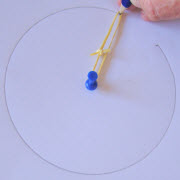 |
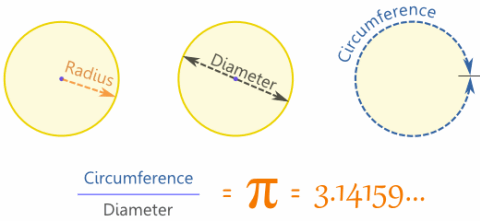
So when the diameter is 1, the circumference is 3,141592654... | 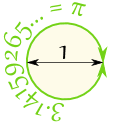 |
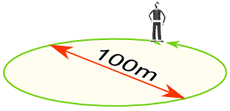 | Distance walked = Circumference = π × 100m = 314m (to the nearest m) |
The circle is a plane shape (two dimensional): And the definition of a circle is: |  |
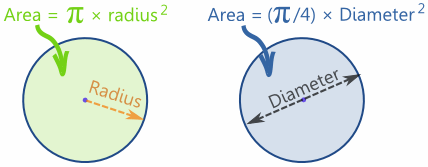
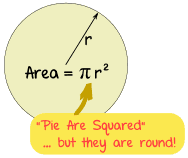
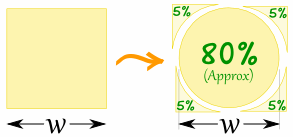
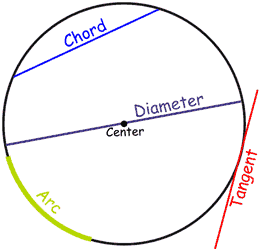
There are two main "slices" of a circle. The "pizza" slice is called a Sector. And the slice made by a chord is called a Segment. | 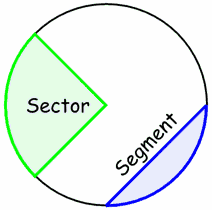 |
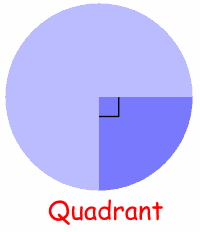 | Quarter of a circle is called a Quadrant. Half a circle is called a Semicircle. |
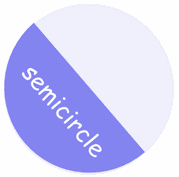 |
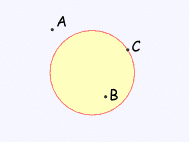 | A circle has an inside and an outside (of course!). But it also has an "on", because we could be right on the circle. Example: "A" is outside the circle, "B" is inside the circle and "C" is on the circle. |
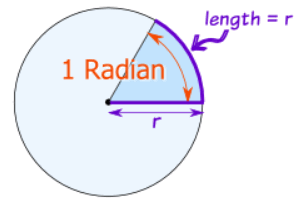
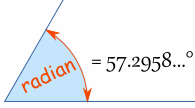 | 1 Radian is about 57,2958 degrees. |
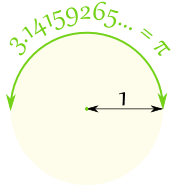
| So: | π radians | = | 180° | |
| So: | 1 radian | = | 180°/π | |
| = | 57,2958...° | |||
| (approximately) |
| Degrees | Radians (exact) | Radians (approx) |
|---|---|---|
| 30° | π/6 | 0,524 |
| 45° | π/4 | 0,785 |
| 60° | π/3 | 1,047 |
| 90° | π/2 | 1,571 |
| 180° | π | 3,142 |
| 270° | 3π/2 | 4,712 |
| 360° | 2π | 6,283 |

| x (radians) | 1 | 0,1 | 0,01 | 0,001 |
|---|---|---|---|---|
| sin(x) | 0,8414710 | 0,0998334 | 0,0099998 | 0,0009999998 |
SlicesThere are two main "slices" of a circle:
|  |
| Sector | Segment |
|---|---|


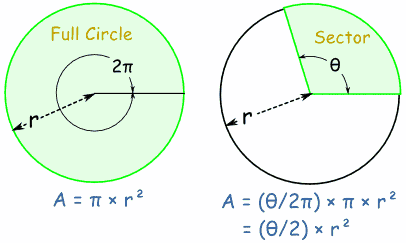
| A circle has an angle of 2π and an Area of: | πr2 | |
| A Sector with an angle of θ (instead of 2π) has an Area of: | (θ/2π) × πr2 | |
| Which can be simplified to: | (θ/2) × r2 |
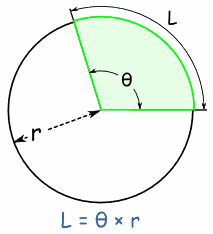 | Arc LengthBy the same reasoning, the arc length (of a Sector or Segment) is: L = θ × r (when θ is in radians) L = (θ × π/180) × r (when θ is in degrees) |
Area of SegmentThe Area of a Segment is the area of a sector minus the triangular piece (shown in light blue here). There is a lengthy reason, but the result is a slight modification of the Sector formula: | 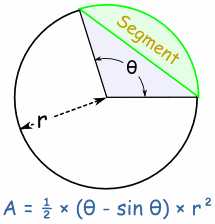 |
Area of Segment = ½ × (θ - sin θ) × r2 (when θ is in radians) Area of Segment = ½ × ( (θ × π/180) - sin θ) × r2 (when θ is in degrees) | |
 | Habit 1 — Be Proactive
You're in Charge
I am a responsible person. I take initiative. I choose my actions, attitudes, and moods. I do not blame others for my wrong actions. I do the right thing without being asked, even when no one is looking.
|
 | Habit 2 — Begin With the End in Mind
Have a Plan
I plan ahead and set goals. I do things that have meaning and make a difference. I am an important part of my classroom and contribute to my school’s mission and vision. I look for ways to be a good citizen.
|
 | Habit 3 — Put First Things First
Work First, Then Play
I spend my time on things that are most important. This means I say no to things I know I should not do. I set priorities, make a schedule, and follow my plan. I am disciplined and organized.
|
 | Habit 4 — Think Win-Win
Everyone Can Win
I balance courage for getting what I want with consideration for what others want. I make deposits in others’ Emotional Bank Accounts. When conflicts arise, I look for Third Alternatives.
|
 | Habit 5 — Seek First to Understand, Then to Be Understood
Listen Before You Talk
I listen to other people’s ideas and feelings. I try to see things from their viewpoints. I listen to others without interrupting. I am confident in voicing my ideas. I look people in the eyes when talking.
|
 | Habit 6 — Synergize
Together Is Better
I value other people’s strengths and learn from them. I get along well with others, even people who are different from me. I work well in groups. I seek out other people’s ideas to solve problems because I know that by teaming with others, we can create better solutions than anyone of us can alone. I am humble.
|
 | Habit 7 — Sharpen the Saw
Balance Feels Best
I take care of my body by eating right, exercising, and getting sleep. I spend time with family and friends. I learn in lots of ways and lots of places, not just at school. I find meaningful ways to help others.
|
Contoh Perangkat Pembelajaran Berikut contoh dokumen Perangkat pembelajran dari mata pelajaran Matematika Contoh Silabus, klik disini ...